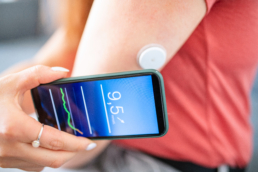Better Patient Outcomes Through Technology
Handheld medical scanners, 3d printed organs, and cure-all healing tanks are the stuff of science-fiction – enabling our favorite heroes to get knocked down, but still pull herself up for the final fight. But what if they’re not all fictional? What if technology is improving patient care to formerly fictional levels?
In case you’re wondering, this isn’t about EHR/EMR systems. According to the National Office of Healthcare Information Technology, 95% of facilities have a certified EHR solution, so we’ll assume you’re familiar with them on some level. What we want to talk about are some of the more incredible uses of technology that are being developed and look at how they may impact the care you’re able to provide your patients.
What’s already here
1. Smart beds
Yes, smart beds. These beds have built-in sensors that feed information on vitals, weight, and even movement during sleep to help nurses react more quickly to changes in patient condition. Another layer of data, they’re helping with everything from misdiagnosis to preventing bedsores.
2. Smart IV pumps
This may actually be one of the first “smart” devices many nurses saw in the field. They’ve been around in some form since the early 2000s. Improvements on data and connectivity over the last decade have increased their usefulness given nurses more time to focus on connecting with their patients.
3. Remote monitors
Remote monitors allow nurses to quickly check a patient, even when they can’t make it to the room. With instant alerts on specific conditions, nurses are able to respond quicker when a patient is in trouble.
4. Telehealth
Adoption of telehealth in multiple forms has grown over the past few years – and with a global pandemic its use has surged in 2020. This is patient care technology at its most necessary time.
5. Flexible, technology-based scheduling
Finding per diem or assignment-based work has never been easier with platforms like Medely that put the power in your hands to choose when, where, and how you work. Sing up today at https://medely.com/professionals/sign_up.

Patient Care Technology – What’s almost here
1. 3D printed… everything
It seems like there’s little these machines can’t do. Several companies are developing printed casts that have seen limited use. When the coronavirus hit the US and PPE was in short supply, open-source 3D models for protective gear were released to the public seemingly overnight. Bioprinted tissue and simple organs are used in pharmaceutical trials and soon researchers seek to unlock 3D printing of complex organs like the heart or kidney. In the next few years, we’re likely to see a large adoption of 3D printed bespoke prescription drugs designed to meet the specific needs of the individual based on height, weight, gender, overall health, and specific clinical needs.
2. The IoT of it all
The internet-of-things (IoT) is a frequent buzzword in patient care technology circles. It covers everything from your refrigerator that recites the weather forecast to the doorbell that lets you see who’s on your front step when you’re on the other side of town (or the world). But it also includes wearables Fitbits and smart watches, as well as more specialized devices like glucose monitors. As savvy consumers connect everything in their lives – including their own health and wellness – there’s an incredible opportunity for the healthcare industry. By capitalizing on patient-generated data to treat them with greater precision and with a more holistic focus.
3. Forget EHRs, bring on CMRs
I know, we said this wasn’t about EHRs… and it’s not. Because over the next decade the barriers to securely connecting sharing private patient information will be solved and we’ll see the emergence of complete medical records (CMRs) that ensure that no matter where a patient seeks care, those doctors, nurses and allied health pros will have a clear picture of their medical history. And as medical IoT increases, that data can be integrated as well… giving medical professionals the edge on treating their patients.
What’s still a ways out
1. Neural interfaces
Long before the Matrix or 2018’s sci-fi actioner Upgrade, sci-fi writers have dreamed of plugging our brains directly into a computer. And while researchers are driving towards making it science-fact, it will still be several more years before it’s ready for wide adoption. Brain-computer interfaces hold the potential to help people with amputations or paralysis to walk and the blind to see.
2. Digital Tattoos
Wearables are great, but you don’t always want to wear a watch. And blood sugar monitors can fall off and are vulnerable to breakage. So if you need 24 hour, fail-safe monitoring a digital tattoo may be the answer. Instead of a permanent injection of ink, digital tattoos are temporary embeds of electrical devices that can be
3. Nanotechnology
Microscopic robots are not fictional, but their medical applications aren’t quite ready for primetime yet. Researchers are hopeful that nanobots will be useful in diagnostics, DNA manipulation, drug delivery, cancer treatment, and even surgery.
What’s never obsolete
As exciting as each of these technologies is, any pro worth their salt knows that human connection is key to better patient outcomes. While your roles may continue to change as capabilities increase, what will always be needed is your calm confidence, your empathy, and your ability to think under pressure. So don’t be afraid to explore and embrace new technologies if they help you provide better care for your patients or give you more time to connect with them.



